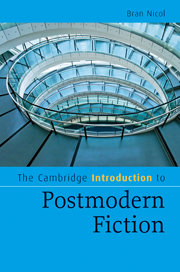Book contents
- Frontmatter
- Contents
- Acknowledgements
- Preface: reading postmodern fiction
- Introduction: postmodernism and postmodernity
- Chapter 1 Postmodern fiction: theory and practice
- Chapter 2 Early postmodern fiction: Beckett, Borges, and Burroughs
- Chapter 3 US metafiction: Coover, Barth, Nabokov, Vonnegut, Pynchon
- Chapter 4 The postmodern historical novel: Fowles, Barnes, Swift
- Chapter 5 Postmodern-postcolonial fiction
- Chapter 6 Postmodern fiction by women: Carter, Atwood, Acker
- Chapter 7 Two postmodern genres: cyberpunk and ‘metaphysical’ detective fiction
- Chapter 8 Fiction of the ‘postmodern condition’: Ballard, DeLillo, Ellis
- References
- Index
- Cambridge Introduction to …
Introduction: postmodernism and postmodernity
Published online by Cambridge University Press: 05 June 2012
- Frontmatter
- Contents
- Acknowledgements
- Preface: reading postmodern fiction
- Introduction: postmodernism and postmodernity
- Chapter 1 Postmodern fiction: theory and practice
- Chapter 2 Early postmodern fiction: Beckett, Borges, and Burroughs
- Chapter 3 US metafiction: Coover, Barth, Nabokov, Vonnegut, Pynchon
- Chapter 4 The postmodern historical novel: Fowles, Barnes, Swift
- Chapter 5 Postmodern-postcolonial fiction
- Chapter 6 Postmodern fiction by women: Carter, Atwood, Acker
- Chapter 7 Two postmodern genres: cyberpunk and ‘metaphysical’ detective fiction
- Chapter 8 Fiction of the ‘postmodern condition’: Ballard, DeLillo, Ellis
- References
- Index
- Cambridge Introduction to …
Summary
There is an episode of The Simpsons in which the barman, Moe Szyslak, tries to transform his dingy bar into somewhere ‘cool’ and futuristic, decorating it with randomly chosen objects such as suspended rabbits and eyeballs. His regulars don't get it. Faced with their non-comprehending stares, Moe explains: ‘It's po-mo!…Post-modern!…Yeah, all right – weird for the sake of weird’ (‘Homer the Moe’, Simpsons Archive).
The Simpsons is widely considered one of the most exemplary postmodern texts because of its self-reflexive irony and intertextuality. But postmodernism is not weird for the sake of being weird. Nor is it simply ‘the contemporary’ or ‘the experimental’. It may be ‘avant-garde’ (though many critics, myself included, think it isn't), or it may be a continuation of the values and techniques of modernism (but then again it may just as plausibly be a break with modernism). It may be an empty practice of recycling previous artistic styles…or a valid form of political critique.
Postmodernism is a notoriously slippery and indefinable term. It was originally coined in the 1940s to identify a reaction against the Modern movement in architecture. However, it first began to be widely used in the 1960s by American cultural critics and commentators such as Susan Sontag and Leslie Fiedler who sought to describe a ‘new sensibility’ in literature which either rejected modernist attitudes and techniques or adapted or extended them.
- Type
- Chapter
- Information
- The Cambridge Introduction to Postmodern Fiction , pp. 1 - 16Publisher: Cambridge University PressPrint publication year: 2009



